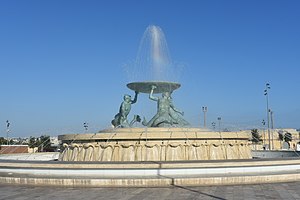| Tritons’ Fountain | |
|---|---|
| Maltese: Il-Funtana tat-Tritoni | |
 Triton Fountain in 2018 | |
| Artist | Vincent Apap Victor Anastasi |
| Completion date | 16 May 1959 |
| Type | Public fountain |
| Medium | Bronze, concrete and travertine |
| Movement | Modernism |
| Subject | Tritons |
| Condition | Restored |
| Location | Floriana, Malta |
| 35°53′44.3″N 14°30′29.8″E / 35.895639°N 14.508278°E | |
The Tritons’ Fountain (Maltese: Il-Funtana tat-Tritoni) is a fountain located in Floriana, Malta. It consists of three bronze Tritons holding up a large basin, balanced on a concentric base built out of concrete and clad in 730 tons of travertine slabs. The fountain is one of Malta's most important Modernist landmarks.[1][2]
Designed and constructed between 1952 and 1959 under no less than three governing bodies, and conceived jointly by eminent sculptor Chevalier Vincent Apap and his collaborator draughtsman Victor Anastasi, the fountain became unofficially operational on Saturday 16 May 1959.[3] The fountain was used as a stage for National Celebrations named 'Mill-Maltin għall-Maltin' and is believed to have jeopardized the relatively compromised structural setup of the sculptural group and consequently contributed to the dramatic collapse of the sculptural group which occurred on Wednesday 1 March 1978 at approximately 14:00hrs.
The sculptural group was repaired by Malta Drydocks engineers between January 1986 and April 1987. During this intervention a central sculptural addition consisting of three seagulls and seaweed (also the work of Chev. Apap) was introduced within the sculptural group, however this arrangement subsequently diminished the telamonic role of the mythological Triton figures.
The fountain deteriorated in subsequent decades, and was earmarked for relocation in 2010 when the Heritage Planning Unit of the Planning Authority through its Conservation Officer Kenneth Cauchi advised that the monumental fountain would be best left in situ and any efforts were to be aimed and restoring the whole structure to its original form and reinstate the sculptural group in its dramatic carrying role of the ponderous basin. Much efforts and meetings were undertaken with Minister of Infrastructure, Communication and Transport Dr. Austin Gatt who stopped all proposals of relocating the fountain in a Press Conference dated 9 December 2011. The proposal by Mr. Cauchi was put forward to be addressed by the Minister of Resources and Rural Affairs George Pullicino who put forward the proposal through his Permanent Secretary Ing. Christopher Ciantar and Architect Norbert Gatt. Eventually the project passed forward by the Head of the Rehabilitation Projects Office (RPO) Chief Architect Mireille Fsadni and under the new Minister of the Ministry of Transport and Infrastructure (MTI) Joe Mizzi and under the new Permanent Secretary Ing Joseph Callus who was instrumental in setting up a technical steering group to address the proposed project by Mr. Cauchi. The team was chaired by Ing. Stefan Calamatta and was made up of Architect Fsadni to cover the civil and structural parts, Mr. Cauchi to cover the historical, artistic and bronze and travertine conservation aspects, Ing Brian Cauchi and Ing Alex Vella (obit. 2023) to cover the mechanical and hydraulic aspects, Ing Conrad Casha and Ing Simon Ellul to address the electrical aspects.
Following the general election of 2017, the project passed under a new Ministry Transport, Infrastructure and Capital Projects (MTIP) with Dr. Ian Borg as Minister and Permanent Secretary Mr. Christopher Cutajar who saw to the undertaking of the project proposed by Mr. Cauchi. The contract for works was entered upon on the 12th January 2017 and commencing on site at the end of January when the bronze figures were dismantled and sent to Fonderia Artistica Ferdinando Marinelli of Florence. Works were ready by the end of the year, and the fountain and piazza were officially inaugurated on 12 January 2018, precisely a year to date from the signing of the contract. The Project Manager was Ing Joseph Scicluna who was instrumental to bring the project to a satisfactory conclusion while the Site Manager was Joseph Mifsud.
- ^ Cauchi, Kenneth (October 2012). "The Tritons' Fountain" (PDF). Vigilo (42). Din l-Art Helwa: 40–43. ISSN 1026-132X. Archived from the original (PDF) on 26 June 2019.
- ^ Rizzo, Victor J. (2010). Discover Floriana: Historic Walks in a Green City (PDF). Din l-Art Ħelwa and Floriana Local Council. p. 28. ISBN 9789990998092. Archived from the original (PDF) on 7 June 2019. Retrieved 7 June 2019.
- ^ Cauchi, Kenneth (January 2018). David Mallia (ed.). "Triton Fountain: Restoration and Inauguration" (PDF). Ministry for Transport, Infrastructure and Capital Projects. pp. 1–43. Archived from the original (PDF) on 30 June 2019.